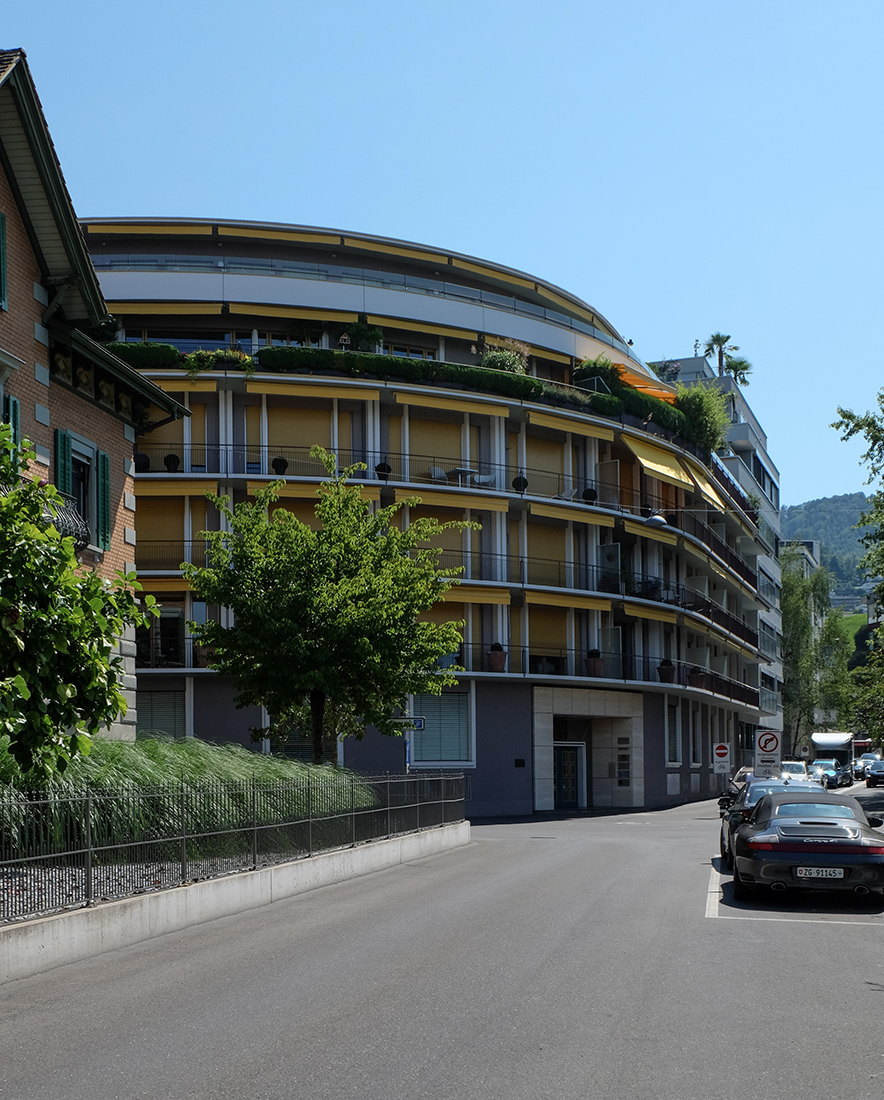 |
 |
 |
 |


Residential & Commercial Building Seepark
Gartenstrasse 4, Zug
1953 - 1955
The Seepark residential
and commercial building in the town of Zug was built
from 1953 to 1955 according to the plans of the
architectural partnership Hanns Anton Brütsch and
Alois Stadler. The building on the northern edge of
Neustadt, not far from the railroad station, is one of
the first residential buildings in Zug to be built in
unmistakable modernity after the Second World War. The
curved shape of the six-story residential and
commercial building follows the building line defined
in 1952. The building is part of a perimeter block
development and features a differentiated street and
courtyard façade. On the ground floor there are
offices and practice rooms. On the floors above are
the apartments. The 5th floor with attic apartment is
set back so that the volume relates to the historical
context. On the street side, a grid facade of slightly
protruding bulkheads and continuous ceiling slabs
rises above the base, creating a narrow balcony zone.
The ceiling slabs as well as the balcony railings
emphasize the horizontal and accentuate the rounded
form. The apartments, with their floor-to-ceiling
windows, benefit from views of Lake Zug. The courtyard
side is characterized by an access gallery, which is
connected to the round stair and elevator tower. The
building was extensively renovated in 1996.
Das Wohn- und Geschäftshaus Seepark in der Stadt Zug wurde von 1953 bis 1955 nach den Plänen der Architektengemeinschaft Hanns Anton Brütsch und Alois Stadler gebaut. Das Gebäude am nördlichen Rand der Neustadt, unweit des Bahnhofs, zählt zu den ersten Wohnungsbauten in Zug, das nach dem Zweiten Weltkrieg in unmissverständlicher Modernität entstanden ist. Das sechsgeschossige Wohn- und Geschäftshaus folgt in seiner gekrümmten Form der 1952 definierten Baulinie. Das Gebäude ist Teil einer Blockrandbebauung und weist eine differenzierte Strassen- und Hoffassade auf. Im Erdgeschoss befinden sich Büros und Praxisräume. In den Stockwerken darüber befinden sich die Wohnungen. Das 4. Obergeschoss mit Attikawohnung ist zurückversetzt, so dass sich das Volumen auf den historischen Kontext bezieht. Strassenseitig erhebt sich über dem Sockel eine Rasterfassade aus leicht vorpsringenden Schotten und kontinuierlichen Deckenplatten, so dass eine schmle Balkonzone entsteht. Die Deckenplatten sowie die Balkongeländer betonen die horizontale und akzentuieren die gerundete Form. Die Wohnungen mit ihren raumohen Fenstern profitieren vom Blick auf den Zugersee. Die Hofseite wird durch eine Laubengangerschliessung charakterisiert, welche an den runden Treppen- und Liftturm angeschlossen ist. Das Gebäude wurde 1996 umfassend renoviert.
Das Wohn- und Geschäftshaus Seepark in der Stadt Zug wurde von 1953 bis 1955 nach den Plänen der Architektengemeinschaft Hanns Anton Brütsch und Alois Stadler gebaut. Das Gebäude am nördlichen Rand der Neustadt, unweit des Bahnhofs, zählt zu den ersten Wohnungsbauten in Zug, das nach dem Zweiten Weltkrieg in unmissverständlicher Modernität entstanden ist. Das sechsgeschossige Wohn- und Geschäftshaus folgt in seiner gekrümmten Form der 1952 definierten Baulinie. Das Gebäude ist Teil einer Blockrandbebauung und weist eine differenzierte Strassen- und Hoffassade auf. Im Erdgeschoss befinden sich Büros und Praxisräume. In den Stockwerken darüber befinden sich die Wohnungen. Das 4. Obergeschoss mit Attikawohnung ist zurückversetzt, so dass sich das Volumen auf den historischen Kontext bezieht. Strassenseitig erhebt sich über dem Sockel eine Rasterfassade aus leicht vorpsringenden Schotten und kontinuierlichen Deckenplatten, so dass eine schmle Balkonzone entsteht. Die Deckenplatten sowie die Balkongeländer betonen die horizontale und akzentuieren die gerundete Form. Die Wohnungen mit ihren raumohen Fenstern profitieren vom Blick auf den Zugersee. Die Hofseite wird durch eine Laubengangerschliessung charakterisiert, welche an den runden Treppen- und Liftturm angeschlossen ist. Das Gebäude wurde 1996 umfassend renoviert.